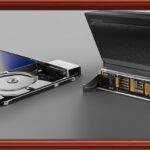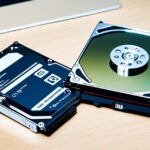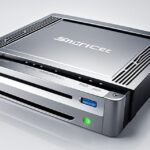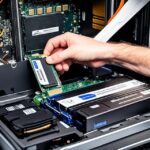Table of Contents
In the world of computing today, solid-state drives (SSDs) have brought a big change. SSDs use flash memory and don’t have spinning parts like old hard disk drives (HDDs). This means they work faster and are more reliable. They are better at storing data and responding quickly.
Now, you can find SSDs with lots of different storage sizes. They range from 128 GB to huge 30.72 TB models. Companies like Samsung and Toshiba made these large SSDs in 201812. Looking at SSDs shows us how they have changed the way we save and access digital information. They make our digital world run smoother and faster.
Key Takeaways
- SSDs utilise flash memory, providing faster access times compared to HDDs.
- With no moving parts, SSDs are less prone to mechanical failure.
- The capacities of SSDs range from 128 GB to 30.72 TB, catering to various needs.
- SSDs demonstrate improved energy efficiency, contributing to longer battery life in laptops.
- Historical advancements in storage technology have seen HDDs hold up to 20 TB commercially.
- Adoption of protocols like SATA and NVMe enhances SSD performance significantly.
- As SSD technology advances, costs are expected to decline, making them accessible for more users.
Introduction to Solid-State Drives
Solid-state drive technology is a big step forward in storing data. SSDs use flash memory, which means they can move data faster. This makes your computer start quicker and work better. By 2024, SSDs could hold up to 200 TB of data. This is huge compared to the 20 MB they held in 19913.
SSDs are made without moving parts. This makes them last longer and less likely to break if you drop them. They also use less electricity and are quieter than old hard drives. And, their speed for reading data in a row has reached up to 14.5 GB/s by mid-2024. This is a lot faster than the 49.3 MB/s in 20074.
SSDs come in different sizes like 2.5-inch, M.2, and U.2. They fit in many devices, from smartphones to big servers4. Also, they have become much cheaper. In 1991, 1 GB cost US$50,000. By July 2020, it was just US$0.053.
More and more people are choosing SSDs to make their computers run better. They make using data easier and change the way we keep our files.
What Type of Hard Drive Has No Moving Parts
Solid-state drives (SSDs) are the top choice in data storage technology. They are fast and efficient thanks to their design. Unlike hard disk drives (HDDs), SSDs use NAND flash memory for storing data. This means they don’t have moving parts that wear out.
Defining Solid-State Drives
SSDs don’t have moving parts, so they don’t fail mechanically like HDDs do. They perform much better. For instance, they can read data up to ten times faster and write data twenty times quicker than HDDs. They come in sizes from 128 GB to 2 TB and some are even 100 TB. SSDs also use technology to last longer, making them reliable1.
Comparison with Traditional Hard Disk Drives (HDDs)
When comparing SSDs with HDDs, SSDs are faster, more energy-efficient, and more durable. Though HDDs might have more storage, up to 20 terabytes, their mechanical parts can fail. This affects reliability1. SSDs, without these parts, often work well for more than 3 to 5 years. This makes them great for places like data centres1.
The gap between SSDs and HDDs is growing, making SSDs more appealing. They were first shown at CES in 2007. Now, they lead the storage solution market. While HDDs may be cheaper at smaller sizes, SSDs offer more benefits. They are faster and use less energy5. Upgrading to an SSD is good for a better computing experience.
The Evolution of Storage Technology
The history of how we store data has seen massive changes. We’ve moved from magnetic tape to advanced solid-state drives (SSDs). Each step forward in the evolution of hard drives shows how our data storage has transformed.
Historical Overview of HDDs
The 1950s introduced hard disk drives (HDDs), revolutionising data storage with rotating disks. Before HDDs, we relied mainly on magnetic tape for storage6. Using neodymium magnets for exact placement of read/write heads improved data retrieval speeds6. Over time, HDDs have become smaller, yet can hold more data, thanks to ongoing tech advances7.
Introduction of SSDs in the Market
In the late 20th century, SSDs started changing data storage. The first commercial SSD, launched in 1991, could store 20MB and cost $1,000, showing the potential and high cost of flash memory8. Unlike HDDs, SSDs access data much faster and don’t have mechanical issues. These modern solutions outpaced HDDs in speed and reliability6. By the 2000s, with PCIe technology, SSDs reached even higher speeds, becoming preferred for quick data access and efficiency8.
| Storage Type | Introduction Year | Initial Capacity | Typical Costs |
|---|---|---|---|
| Magnetic Tape | Mid-20th Century | Varied | Low |
| Hard Disk Drives (HDDs) | 1950s | 1 MB > | High |
| Solid-State Drives (SSDs) | 1991 | 20 MB | $1,000 |
| PCIe 4.0 SSDs | 2020 | Varied (up to several TB) | Moderate to High |
Advantages of SSDs Over HDDs
Switching from hard disk drives (HDDs) to solid-state drives (SSDs) is a big leap in storage tech. SSDs are much faster, making everything from booting up to loading games quicker. A 20 GB movie can be transferred in less than 10 seconds on an SSD9. On an HDD, this would take about two minutes9. Standard SSDs hit speeds up to 550 MB/s, while HDDs lag at 50-120 MB/s10. Top-tier NVMe SSDs can reach speeds up to 14,500 MB/s11.
Speed and Performance Improvements
With SSDs, you’ll see a huge cut in how long you wait for apps and games to start11. Plus, as SSDs have become cheaper, they’re easier for more people to buy. This is true even though they used to cost more than HDDs.
Energy Efficiency and Durability
SSDs are not just fast; they’re also more power-efficient. They use less electricity, which means longer battery life for laptops and lower energy bills10. Also, SSDs don’t have moving parts. This means they’re less likely to break if dropped, and they work well in all kinds of temperatures9. Because they’re so reliable, SSDs can last over ten years, making them a smart choice for anyone9.
FAQ
What are solid-state drives (SSDs)?
Solid-state drives use flash memory for fast data access, without any moving parts. They’re quicker, more reliable, and perform better than hard disk drives (HDDs).
How do SSDs differ from HDDs?
SSDs and HDDs are different in design and how they work. HDDs use spinning disks and moving heads to read/write data. SSDs, however, use flash memory. So, they’re much faster, use less power, and are more durable.
What are the advantages of using SSDs?
SSDs make your device start up and load apps faster. They’re also more durable because they don’t have moving parts. They use less energy and don’t get as hot. These perks make SSDs great for many uses.
Why are SSDs becoming more popular?
SSDs are getting more popular because they work so well, are getting cheaper, and meet the growing need for quick, reliable storage. They’re great for gaming and work.
What types of SSDs are available?
You can choose from different SSDs like SATA SSDs, which use the SATA interface. Or NVMe SSDs, which are faster and use PCIe. There are also M.2 and U.2 SSDs, perfect for slim laptops and servers.
How has storage technology evolved over the years?
Storage has come a long way from magnetic tape to HDDs, which changed how we store data. SSDs are a big leap forward. They overcome HDDs’ limits, offering quicker and more efficient data handling.
Are there any disadvantages to using SSDs?
SSDs have downsides, like costing more at first and having limited write cycles for some flash types. But, technology is improving to fix these issues.
How can I choose the right SSD for my needs?
To pick the right SSD, look at how much storage you need, the speeds, and the size and connection. Think about what you’ll use it for, whether that’s for high-speed tasks or just extra space.
Is upgrading to an SSD worth it?
Moving to an SSD is worth it for most. It makes your computer work faster and more smoothly. This upgrade can improve your computer use at home or at work.
Source Links
- https://www.ibm.com/think/topics/hard-disk-drive-vs-solid-state-drive – Hard Disk Drive (HDD) vs. Solid State Drive (SSD) | IBM
- https://www.pluralsight.com/blog/it-ops/types-of-hard-drives-sata-ssd-nvme – SSD Guide
- https://en.wikipedia.org/wiki/Solid-state_drive – Solid-state drive
- https://www.techtarget.com/searchstorage/definition/SSD-solid-state-drive – What is an SSD (Solid-State Drive)?
- https://www.volico.com/hard-disk-vs-solid-state/ – Traditional Hard Drives VS Solid-State Drives | Vault Networks
- https://www.stanfordmagnets.com/the-evolution-of-hard-drive-magnetic-technology.html – The Evolution of Hard Drive Magnetic Technology | Stanford Magnets
- https://www.recordnations.com/articles/media-history/ – The History of Computer Storage Devices | Record Nations
- https://insights.samsung.com/2021/12/22/the-evolution-of-solid-state-drives-ssds/ – The evolution of solid state drives (SSDs)
- https://www.avast.com/c-ssd-vs-hdd – SSD vs. HDD: Which Do You Need?
- https://www.kingston.com/en/blog/pc-performance/benefits-of-ssd – The 5 Benefits of SSDs over Hard Drives- Kingston Technology
- https://www.crucial.com/articles/about-ssd/ssd-vs-hdd – SSD vs HDD: Know the Difference








